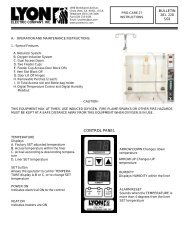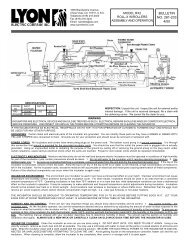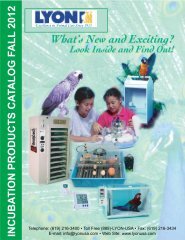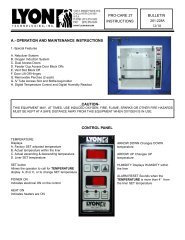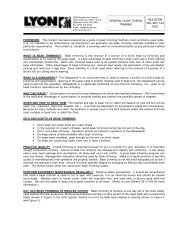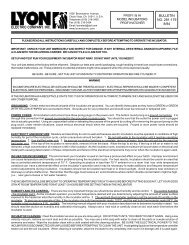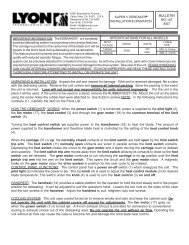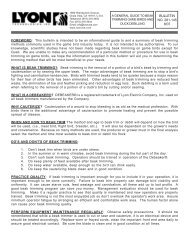observations on 6-10 day old precision beak trimming b281 ... - Lyon
observations on 6-10 day old precision beak trimming b281 ... - Lyon
observations on 6-10 day old precision beak trimming b281 ... - Lyon
You also want an ePaper? Increase the reach of your titles
YUMPU automatically turns print PDFs into web optimized ePapers that Google loves.
Page 2<br />
Some operators prefer the gauge without the cooling tube and feel the hot gauge aids in the cauterizati<strong>on</strong> process. You<br />
should know however that a properly heated blade will approach 1400 o F and over a period of operati<strong>on</strong> can raise the<br />
gauge temperature to 600-<strong>10</strong>00 o F which can easily burn the operators fingers. When <strong>beak</strong> <strong>trimming</strong> this way the operators<br />
finger should be taped for protecti<strong>on</strong>. The positi<strong>on</strong> of the gauge (regardless of the <strong>on</strong>e used) to the blade is very<br />
important. It should be centered <strong>on</strong>, and be square with, the blade and adjusted to the inside to a point tat the blade<br />
strikes the back of the gauge slightly as it comes down. This produces a scissor acti<strong>on</strong> <strong>on</strong> the <strong>beak</strong> and makes a square<br />
cut. You will note that the top edge of the gauge is bent out at an angle to allow the blade to complete the acti<strong>on</strong> without<br />
jamming the blade and gauge.<br />
The gauge is made of stainless steel and is quite thin. It must be this way. Too thick of a gauge would cause areas of the<br />
gauge to sear any area of the <strong>beak</strong> it is in c<strong>on</strong>tact with and would not be flexible enough for good scissors acti<strong>on</strong>.<br />
Finally-but of utmost importance-it is at this point that a lot of poor precisi<strong>on</strong> <strong>beak</strong> <strong>trimming</strong> takes place. The birds <strong>beak</strong><br />
should be inserted into the hole with the birds head square and straight with the gauge. How the head is held is how the<br />
<strong>beak</strong> <strong>trimming</strong> will be d<strong>on</strong>e, square or crooked, (This is why we emphasize operator and De<strong>beak</strong>er positi<strong>on</strong>ing). The<br />
<strong>beak</strong> should be held in this positi<strong>on</strong> THE ENTIRE TIME THE BLADE IS IN CONTACT WITH BEAK. Failure to do this will result in<br />
improper cauterizati<strong>on</strong> time. The growth of the <strong>beak</strong> roots will not be inhibited properly and the <strong>beak</strong> may grow out again.<br />
If this does occur another <strong>beak</strong> <strong>trimming</strong> will required. A handrest will aid greatly in h<strong>old</strong>ing the bird properly and steady<br />
during the <strong>beak</strong> <strong>trimming</strong> operati<strong>on</strong>.<br />
THE BLADE: The blade most often used for precisi<strong>on</strong> <strong>beak</strong> <strong>trimming</strong> is the BC type. It has two cutting edges so that when<br />
<strong>on</strong>e edge becomes dull it can be turned over and the other edge used.<br />
The blade is mounted so that the FLAT EDGE of the cutting edge used is towards the operator (the beveled edge is away<br />
from the operator). This produces the scissor acti<strong>on</strong> discussed in the paragraph <strong>on</strong> the gauge. We are amazed at the<br />
amount of people who mount the blade with the beveled edge towards the operator.<br />
When the blade is mounted wr<strong>on</strong>g, the cutting takes place away from the gauge hole (Blade thickness and the balance<br />
of the <strong>beak</strong> is literally seared off to the back of the gauge. A mutilated <strong>beak</strong> results, often with tenderness to the <strong>beak</strong><br />
that inhibits eating for the life of the bird. A needless loss.<br />
We stressed the point that the birds head must be square and straight during the <strong>beak</strong> <strong>trimming</strong> and cauterizati<strong>on</strong><br />
process. If the birds head is not square, a blade cut made at an angel can leave a sharp protrusi<strong>on</strong> that negates the<br />
whole value of <strong>beak</strong> <strong>trimming</strong> as the bird still has an effective means to peck despite the end of the <strong>beak</strong> being g<strong>on</strong>e.<br />
DETERMINED BLADE TEMPERATURE BY COLOR: When the precisi<strong>on</strong> <strong>beak</strong> <strong>trimming</strong> method was first introduced, the innovator<br />
said the blade must be “Cherry Red”. It didn’t take too l<strong>on</strong>g to find however, that what <strong>on</strong>e pers<strong>on</strong> called “cherry red”<br />
was c<strong>on</strong>siderably different from another. We found that the difference between peoples interpretati<strong>on</strong> of “cherry red”<br />
resulted in temperature differences by measurement of up to 600 o F.<br />
When the blade is first heated (each time, new or <strong>old</strong>) it builds up resistance to current as it heats up. This increase of resistance<br />
lowers the current flow through the blade up to 6% when it becomes completely hot. For this reas<strong>on</strong> a slight readjustment<br />
of color may be required about 5 minutes first being turned <strong>on</strong>.<br />
Another factor to c<strong>on</strong>sider in determining blade color vs. temperature is that a new blade is bright in color when new. As<br />
it heats, oxides are produced <strong>on</strong> its surface causing the blade to become a dull color. It is the color observed <strong>on</strong> an oxidized<br />
blade that is most accurate in determining temperature. Once a setting is determined for use it should be left there.<br />
The <strong>on</strong>ly change necessary would be if the line voltage for the De<strong>beak</strong>er should drop and stay lower for a period of time.<br />
A new c<strong>on</strong>tact high temperature thermometer which can accurately and quickly measure precise blade temperature is<br />
now available from Ly<strong>on</strong> at a reas<strong>on</strong>able cost. It enables you to set your De<strong>beak</strong>er (s) at the correct temperature setting<br />
and to maintain that temperature for optimum results. WE HIGHLY RECOMMEND THIS DEVICE TO ALL USERS! Inquire<br />
about Catalog# 500-025.




